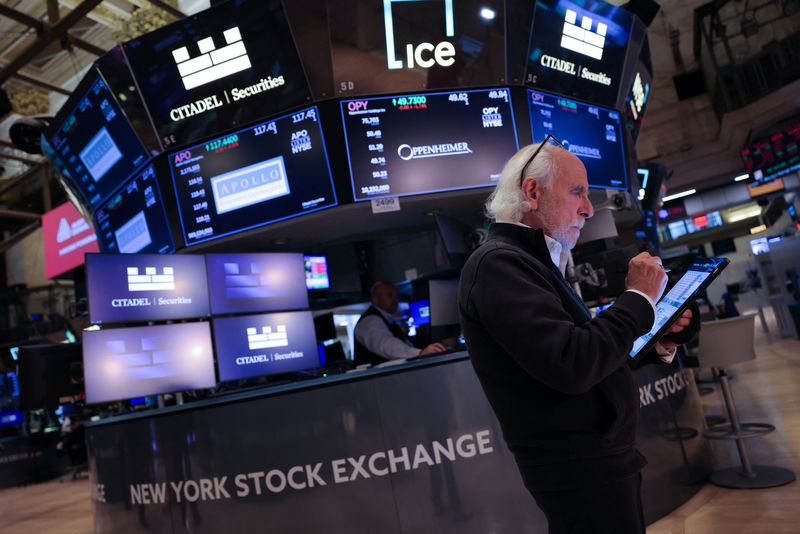Market calm yields to stocks surge as investors cheer Fed rate cut
By Saqib Iqbal Ahmed, Suzanne McGee and Carolina Mandl
NEW YORK (Reuters) -An initial muted market reaction following the Federal Reserve’s first rate cut in four years gave way to a surge in U.S. stocks as uncertainty ebbed and investors digested the implications of easing monetary policy.
The S&P 500 was up 1.7% on Thursday, hitting a fresh intraday high. The rally was a sharp contrast to the day before, when the benchmark index closed down 0.3% following a 50-basis-point rate cut from the Fed. Treasury yields, which move inversely to bond prices, continued to rise.
The Fed meeting had been seen as a potentially pivotal event for markets, with rates futures gyrating hours before the event as traders recalibrated bets on how big the initial rate cut would be.
Some of that uncertainty has been removed, now that the first rate cut is in the books and the central bank has assured markets that the jumbo-sized reduction was an insurance measure to safeguard the economy and not an emergency response to recent labor market weakness.
That leaves investors to focus on metrics such as corporate earnings growth, which has been solid this year, said Michael Purves, CEO of Tallbacken Capital Advisors.
"If stocks are rallying, it’s more about the fact that the Fed meeting is behind us," Purves said.
With monetary policy less restrictive, investors may also be factoring in better chances of an economic soft landing, where the Fed is able to cool inflation without badly hurting growth, said Ed Yardeni, founder of Yardeni Research.
"Now that the Fed is stimulating the economy, the hard-landing crowd should disperse," Yardeni said in a Thursday morning report.
Lower rates are likely to benefit smaller, highly leveraged companies that rely on cheaper debt as well as economically sensitive-value stocks, Yardeni said. The rally that had pushed the S&P 500 up 18.5% this year through Wednesday will likely broaden from the cluster of big tech names that have led the gains, he added.
The small-cap focused Russell 2000 index was up 1.8% on Thursday after finishing about flat in the previous session.
Strategists at Societe Generale (OTC:SCGLY ) echoed that view. They recommended clients buy stocks in the consumer discretionary and consumer staples sectors, expecting them to receive a boost as falling mortgage rates and further declines in oil prices benefit spending.
"The clearest trade is the change in leadership for U.S. equities that favors a broadening of performance," they wrote.
Stocks could be supported in the near-term as a swing from a hard-landing outlook to a soft-landing view prompts defensively positioned investors to “grab-and-chase” upside in stocks, Nomura strategist Charlie McElligott said in a note.
Historically, equities tend to respond well to falling rates as long as a recession is avoided, according to data from Keith Lerner, co-chief investment officer at Truist Advisory Services, which showed the S&P 500 higher a year after the first cut in four out of six Fed easing cycles since 1989.
That does not exclude the possibility of volatility in the shorter term, however, as the Fed decision ripples through markets.
"The coming hours could prove dangerous ... with traders exposed to sudden riptides as rate expectations are reinforced in other economies," said Karl Schamotta, chief market strategist at payments company Corpay, commenting on foreign-exchange markets.
The dollar was little-changed against a basket of currencies on Thursday, hovering near its lowest level in about a year.
Investors were also looking ahead to Friday, when the quarterly expiration of stock options, stock index options and futures - totaling some $5.1 trillion in notional terms, according to SpotGamma - ramps up the risk for volatility in equities as traders adjust their positions.
MUTED REACTION
Stock options had priced a roughly 1.1% swing, up or down, for the S&P 500 on Wednesday, according to options analytics service ORATS. Instead, the index snapped a seven-day winning streak to finish down 0.29%.
Big gains in stocks and a slide in the dollar in the days ahead of the Fed meeting may have led to the underwhelming reaction, said Sonu Varghese, global macro strategist at Carson Group.
"It's a very silly cliche, 'buy the rumor, sell the news', but that's kind of what happened," said Matt Diczok, head of fixed income strategy at Merrill and Bank of America Private Bank.
Treasury yields, which rise when bond prices fall, kept climbing on Thursday, taking the benchmark 10-year yield to 3.75%.
The move was exacerbated by weekly jobs data showing continued strength in the labor market.
With the Fed meeting in the rear-view mirror, "attention will once again shift toward the incoming data to further refine the macro narrative," BMO Capital Markets rates strategists wrote.
Source: Investing.com
